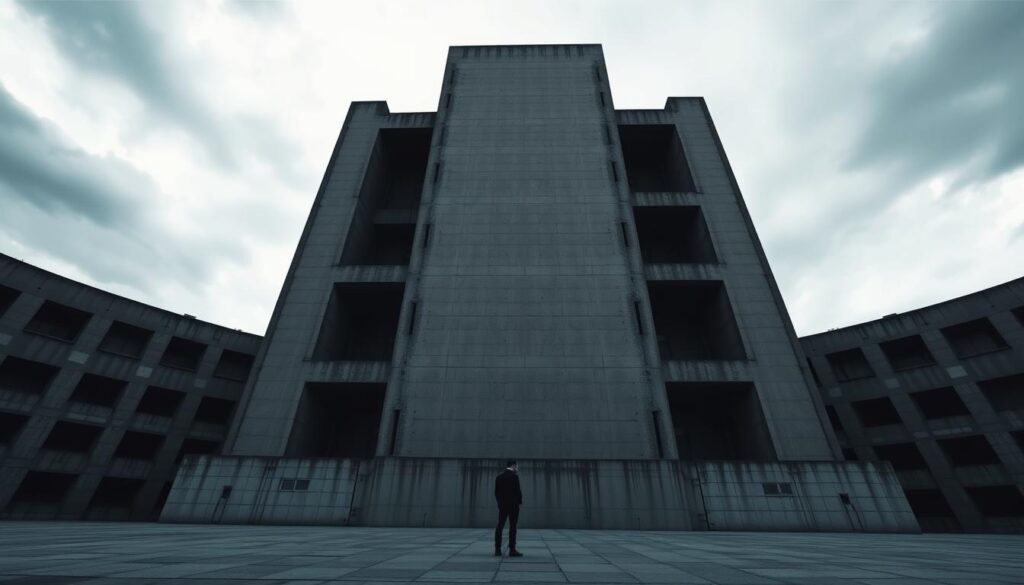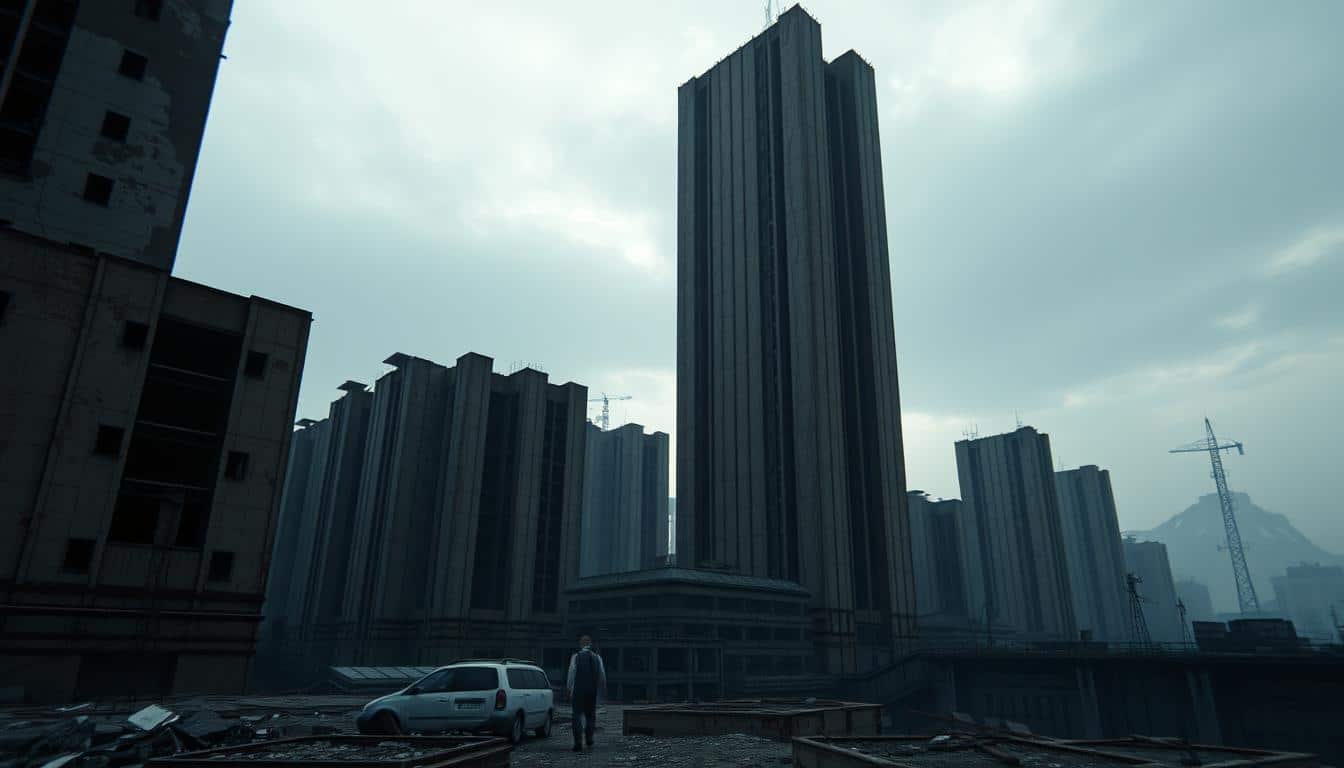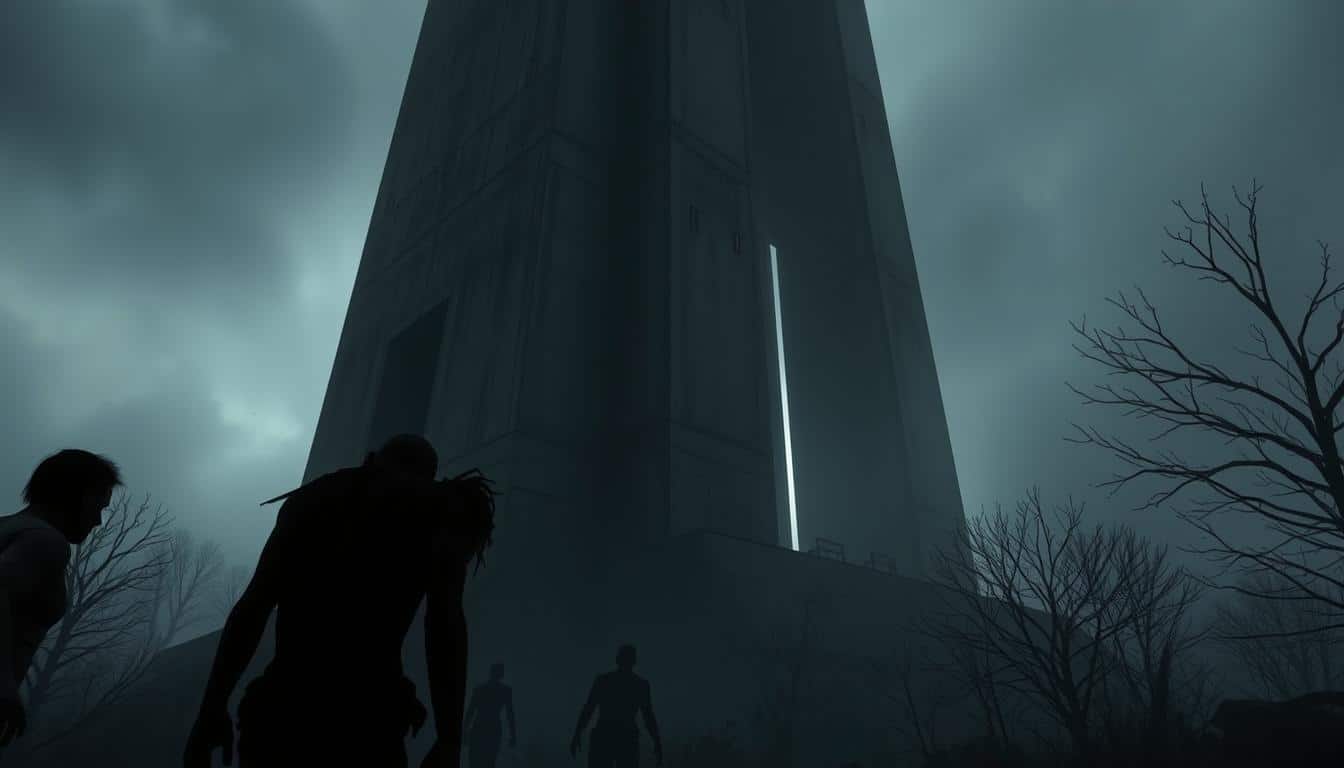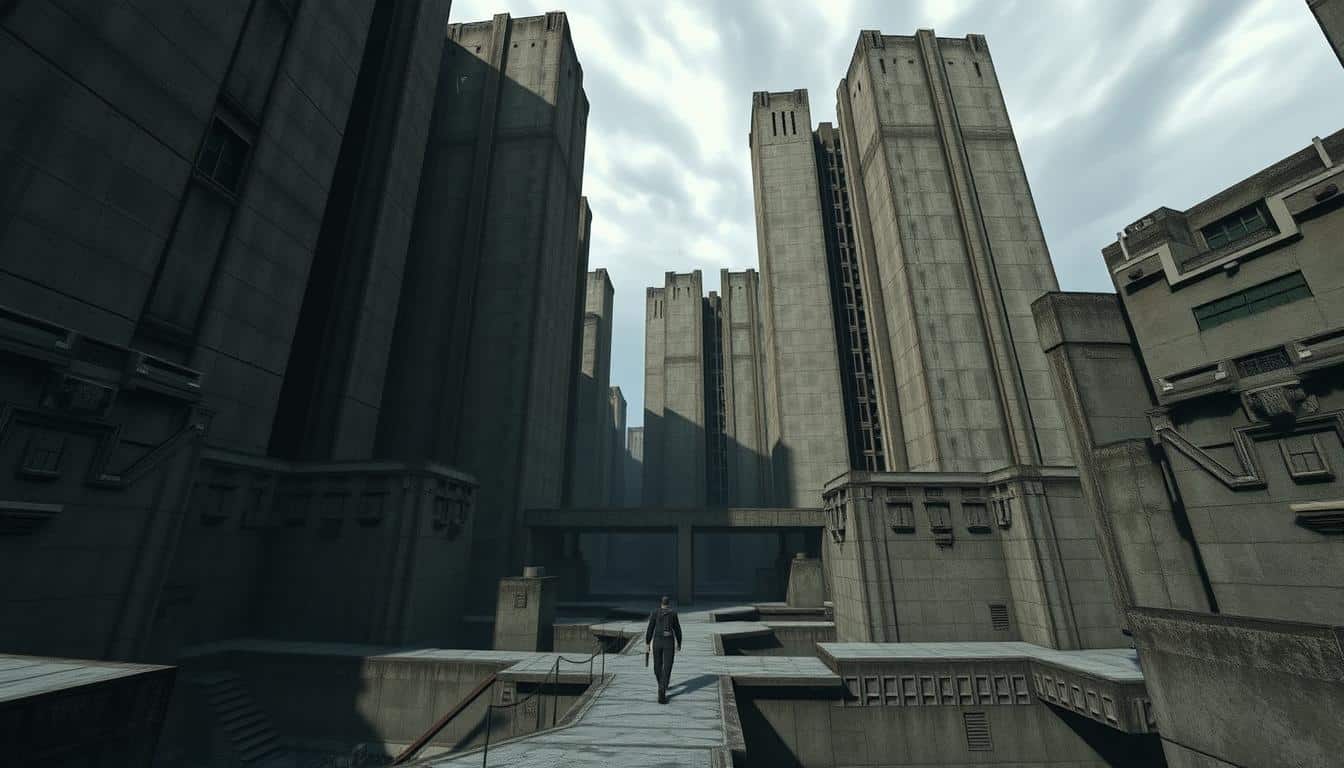Dive into a digital journey exploring famed Soviet brutalist architecture. It’s known for its bold rawness and grand size. This piece takes you through how architecture meets video game design. It shows how these iconic buildings appear in game worlds.
From towering structures to stark facades, we look at the creativity and history behind these brutalist landmarks. They’re not just historically significant. They also influence today’s gaming world with their unique style.
The Rise of Brutalism in Architecture
The rise of brutalism was a major change in how buildings were designed, happening after World War II. It was born from a need for cheap, quick construction during city rebuilds. Known for its plain concrete look, brutalism mirrored the era’s push for simplicity and practicality. With its bold shapes and tough appearance, it showed a new side of architecture. Designers chose to leave materials like concrete exposed, adding to its strong and utilitarian vibe.
Historical Context of the Brutalist Movement
Brutalism began shaping up in the late 1940s. Architects were looking to meet the community’s social and financial needs then. They often used raw concrete, or béton brut, which set this style apart. This move to simpler, more direct designs marked a big step away from fancy detailing. The focus was more on what a building did than how it looked, echoing a broader move towards being practical.
Characteristics of Brutalist Design
Several defining characteristics set brutalist design apart:
- Raw materials: Unfinished concrete surfaces are typical, emphasizing a connection to the material’s natural state.
- Geometric shapes: Large, block-like structures and angular forms dominate the skyline, showcasing strength and durability.
- Functional spaces: Interiors are often designed with practicality in mind, facilitating efficiency and utility.
- Rejection of ornamentation: The focus on minimalism highlights structural elements without decorative distractions.

Understanding Soviet Brutalism
Soviet brutalism became a key architectural style in the USSR. It showed the goals of communist architecture. The buildings are large and strong, making you feel the power and control they stand for. Soviet brutalism’s main traits are its simple, stark designs and the cheap materials used. These create huge shapes that stand out in cities.
Key Features of Soviet Brutalist Architecture
The distinct features of Soviet brutalist architecture make it unique.
- Strict geometrical forms
- Massive constructions that often loom over their surroundings
- Utilization of raw, inexpensive materials such as concrete and steel
- Functional designs that prioritize utility over ornate decoration
Historical Significance in USSR
These buildings were not just practical. They also showed the beliefs of the socialist government. They were all about being useful and grand, showing what was important then. Places like the Palace of Ceremonies in Tbilisi are perfect examples. They show how Soviet brutalism combined use with the USSR’s ideals.
Exploring Soviet Brutalist Landmarks in Gaming Worlds
Gaming brings Soviet brutalist landmarks to life in a unique way. These massive structures and their concrete look get reborn in digital worlds. Developers use these elements to make deeply engaging settings. This lets players experience the stark beauty of Soviet architecture.
Players get to roam through digital worlds that reflect brutalist designs closely. The blend of real architecture with game design creates a special visual language. It captures the buildings’ essence and offers a fun gameplay experience. Iconic structures do more than just set the scene; they help tell the story and add to the game’s emotional journey.
Exploring these virtual spaces brings players closer to Soviet architecture. The raw materials and geometric shapes of brutalism become key parts of the game. This mix of architecture and story helps players value the landmarks’ cultural and historical importance. At the same time, they enjoy engaging gameplay and stories.
Impact of Brutalism on Video Game Design
Video games have started to really embrace the look and feel of brutalism. This style’s distinct starkness and rough beauty are now part of game worlds. Game makers use unpolished textures and industrial vibes to pull players into the story.
They mix concrete, steel, and glass to create strong moods. This mix makes the game’s world more gripping for the player.
How Levels Are Constructed Using Brutalist Principles
When building game levels with brutalism in mind, simplicity and use come first. Game designers make spaces open and shapes sharp. This lets players move through complex places more easily.
They focus on making every design element useful for gameplay. This method makes exploring fun and rewarding for players.
- Use of concrete textures to create a sense of realism
- Incorporation of large, imposing structures for dramatic effects
- Establishment of clear sightlines to guide player movement
Aesthetic Appeal of Raw Materials in Gaming
Raw materials really boost the feel of game worlds. The rough look of these materials pulls players right in. It encourages them to interact with the game environment more.
Showing these raw elements makes game worlds seem real and full of life. It mirrors the real brutalist buildings that inspire these game designs.
Iconic Examples of Soviet Brutalism in Games
Games let players see historical architecture in a new light. Developers get inspired by real Soviet landmarks for their games. They mix reality and virtual worlds, making an interesting mix of old and new. This mix is seen in video games that stay true to the original architecture but still add something new.
Notable Structures and Their In-game Representation
In games like Control, Soviet architecture is reimagined. The Oldest House shows brutalism’s simple, powerful style. It adds to the story and makes the game’s world tense. Players moving through these areas see the game’s world mirror the solid feel of real Soviet buildings.
Comparison to Real-life Soviet Landmarks
Virtual and real Soviet buildings have a lot in common. Games often use dramatic light and big sizes to draw players in. For instance, the Oldest House’s large halls and simple looks remind players of places like the Kurchatov Institute. This connection helps show the importance and critique of these big structures in culture.
Immersive Experiences of Brutalist Landscapes
Brutalist landscapes in video games give players a deep way to interact with their settings. These places catch your eye with their unique look. They also stir feelings of discovery and emotion. Players find themselves deeply pulled into these games. They walk through bold structures that boost more than just moving around.
Player Interaction with Brutalist Environments
Players often journey through large, bare spaces built with brutalism in mind. This style helps create a lone feeling that makes the story better. Players might climb a concrete giant or see how light and shadow play together. Such actions pull them further into the game. Important parts of interacting with the game include:
- Engagement with environmental storytelling
- Exploration of hidden areas and secrets
- Understanding the architectural significance through gameplay
The Role of Sound Design in Enhancing Atmosphere
Sound design plays a big role in making brutalist landscapes even more striking in games. It uses natural sounds that match the big, empty spaces, making players feel more alone. This creates a stronger bond between what players see and hear. How sound helps the game feel real includes:
- Dynamic audio effects that mirror player movements
- Layering ambient soundtracks to create mood
- Utilizing silence strategically to evoke tension
The Cultural Significance of Soviet Brutalism in Gaming
Soviet brutalist structures in games symbolize deep architectural meaning. They show power and control, hinting at the harsh regime behind them. The way these buildings are represented in games adds more than just beauty. It lets players dig into rich stories and themes.
Brutalism as a Symbol of Power and Control
Brutalism’s stark look brings out feelings of authority. When players face these buildings, they dive deep into the game and think about social order. This style sets the scene for stories about power. It makes players face issues like oppression and how societies are run.
How Games Frame the Narrative Around Brutalist Structures
Games use stories to make players connect with brutalist settings. Developers tie these plots to history, making gameplay deeper. This not only makes the game more engaging but also gets players thinking about what buildings symbolize. By placing characters in these massive structures, games start talks on control, space, and life. This focus on Soviet brutalism enriches the gaming world.
Architectural Inspirations from Video Game Titles
Video game architecture is inspired by many art movements, with brutalism being very influential. In games like Control and NaissanceE, the buildings help create worlds that are captivating. They make the gameplay feel more real and interesting.
Case Study: ‘Control’ and The Oldest House
The game Control features a building called the Oldest House. This building uses brutalist design, which makes it look unique and imposing. The concrete walls and shapes make players feel uneasy yet intrigued. This setting changes as you play, linking closely with the story.
As players move through the game, they feel more connected to its world. They get to see how brutalist architecture influences the game’s atmosphere. This helps the story progress in an engaging way.
Exploring Design Choices in ‘NaissanceE’
NaissanceE takes a different approach to game architecture. It uses surrealism to create spaces that feel both strange and beautiful. The game’s design includes remarkable buildings and soft lighting. This adds to its appeal.
NaissanceE encourages players to look closely at its world. The beauty and original gameplay make people want to explore every part. It shows how architecture can enrich a gaming experience.
Modern Representations of Soviet Brutalist Landmarks
There’s a growing love for brutalism in today’s culture, especially in video games. Developers use these bold architectural styles to connect with people. This part talks about how old Soviet brutalist landmarks shape today’s game design.
Revival of Interest in Brutalism
The comeback of brutalism is due to its striking look and use of simple materials. People now want realness in design, making brutalism popular again. Architects are looking back at brutalism’s key ideas, showing they still matter in our cities.
Linking Real-world Structures to Game Design
Using real brutalist landmarks in games makes the gaming world feel more real. Game creators mimic the big size and exact shapes of these buildings to pull players in. This mix of architecture and gaming shows how buildings can shape the way we play.
The blend of gaming and architecture underlines brutalism’s place in culture today.
Challenges in Adapting Brutalist Architecture to Digital Worlds
Bringing brutalist architecture into digital games is tough. Developers aim to mimic concrete and angular structures while keeping gameplay fun. They must think about how to adapt architecture and innovate texture use.
Texture and Material Representation in Games
When it comes to brutalism in games, textures are key. Developers need to make digital concrete look real. This means they have to:
- Creating high-resolution texture maps
- Incorporating realistic shading techniques
- Utilizing normal maps to enhance surface details
By using these methods, they ensure the game feels authentic to players. It mirrors the original brutalist style well.
Balancing Aesthetics and Gameplay Mechanics
Game makers constantly juggle making a game look good with keeping it playable. A game must look amazing and be fun to play. They focus on:
- Ensuring navigation remains intuitive despite complex structures
- Maintaining frame rates while rendering detailed environments
- Designing interactive elements that harmonize with the surrounding architecture
By overcoming these hurdles, they create games that draw players in. They also link players to the beauty of brutalist architecture.
The Future of Soviet Brutalist Landmarks in Gaming Worlds
The gaming world is changing fast, and Soviet brutalist landmarks are becoming more important. We’ll see games that are more real and engaging. They will show the cool, bold look of brutalism. New tech and creative ideas will help game makers tell stories set in these architectural wonders.
Predictions for Upcoming Games
Soon, games will focus on the distinct look of Soviet brutalist buildings. Game makers will use new tech to make these famous places come alive. Players will get to explore them. These games will do more than just show what brutalism looks like. They will make you feel something. They will make you think about power and who’s in charge.
The Evolving Relationship between Architecture and Gaming
Games and buildings are starting to mix in exciting ways. Games will make you see and feel buildings differently. They will connect the big, bold ideas of brutalism to how we play games. This mix will make game stories deeper.
Players will get to check out more complex designs. These designs show that Soviet brutalist landmarks still matter a lot in games.
Conclusion
In summary, mixing Soviet brutalist landmarks in games offers a deep dive into architecture’s impact and player engagement. These buildings have a rich history. They’re not just scenery; they shape stories and experiences in games.
By using brutalism, games highlight its importance as a cultural symbol and story tool. This style shows history and grabs player attention with new interpretations. When players move through digital brutalist places, they feel a strong link between the game’s story and the buildings.
Looking at Soviet brutalism in games helps us see how architecture changes gameplay and society. Putting these buildings into game stories shows they’re still important. They inspire new designs and experiences, keeping them essential in games.



